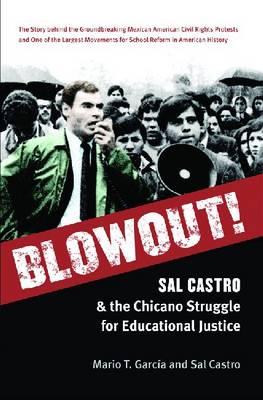BLOWOUT!: Sal Castro & the Chicano Struggle for Educational Justice.
by Mario T. Garcia and Sal Castro
Blowout! is the testimonio of American educator and activist Sal Castro. A phrase adapted by a Garfield High School student from a jazz term that means “to be expressive”, Blowout! was heard from tens of thousands of high school students, primarily Chicano, as they walked out of their classrooms in 1968 in protest at the poor quality of education they were receiving in East L.A. Carried out over a ten year period, this book is the result of hundreds of hours of recorded conversations compiled by historian Dr. Mario Garcia with Sal Castro as well as with a wealth of other students, teachers, administrators, artists and activists who knew Sal personally, many of whom had also been part of the 1968 High School Blowouts.
These blowouts are hailed as the impetus of the urban Chicano Movement, following on from the rural Chicano Movement that had begun some time earlier with Cesar Chavez and the United Farm Workers thus placing Sal Castro as one of the most important Chicano Civil Rights activists of the 60s and 70s. This is the first time his story has been written.
Garcia frames the main autobiographical text of Blowout! with an introduction and epilogue that situate Castro’s story within that of the larger Chicano Movement. In the afterword, Garcia outlines the strong links between Castro’s approach to teaching and the theories of Brazilian pedagogue and educational theorist, Paulo Freire. While Freire is no stranger to most educators today, during the 60s and 70s his work was not widely read outside of Latin America. Castro was completely unaware of his work. However, the concepts of conscientização (conscientization or critical consciousness) are undeniably present as you read through the testimony of Sal Castro.
Unlike most other testimonios, Garcia peppers Castro’s accounts with quotes from different people and news articles. While there is the obvious danger of fracturing the narrator’s story, in this case it has worked quite well and the fluidity of the text is maintained. Moreover, Castro repeatedly emphasises his desire to empower the students and community, to have them speak out so the infrequent additions adds a symbolic connection between teacher and community that suits the text.
Blowout! tells the story of Sal Castro from his early childhood in Mexico to his present retirement. His firsthand experience of discrimination in the U.S. educational system as both a student and educator; in the U.S. Army where he experiences Jim Crow during his travels in the South; and society in general like when his father is returned to Mexico after WWII as part of the “repatriation” program thus forcing his parents to separate, which ultimately leads to their divorce, all provide insights into the challenges faced by immigrant communities in the U.S. at the time. These experiences would also help Castro as he critically assessed and challenged the U.S. education system. He gives personal accounts of the Zoot Suit riots, the Watts riots, the Chicano Moratorium against the war in Vietnam and more. As a teacher of history and politics as well as his background in campaigning for various senators – including John and, later, Robert Kennedy – Castro masterfully contextualises the political and social climate of the 60s and 70s in the build up to, and the later repercussion of, the blowouts, all the while managing to maintain a sense of humour that can only endear him to the reader.
This book is a strong asset not only to Chicano Studies but also to U.S. History, Political Sciences and Education Studies. While it is the testimonio of Sal Castro, it is ultimately the story of young High School students who finally found a teacher who believed in them and gave them the courage and opportunity to protest the inequalities they already knew about and faced daily in their schools and colleges. Although many problems still persist in the education system, the enduring legacy of the blowouts is visible in the ever increasing enrollment of Chicanos and Latinos at third level institutions, a greater presence of Latinos as teachers as well as on educational boards and the emergence of Chicano Studies as an elective in High Schools.


